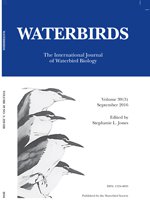Collisions with power lines are a widely documented cause of avian mortality. Estimating total mortalities from counts of carcasses is usually accomplished by quantifying biasing factors, but neither crippling nor nocturnal biases are well understood. From 4 March through 13 April 2009, data were collected on Sandhill Crane (Grus canadensis) collisions involving a 69-kV transmission line crossing the Platte River in Nebraska, USA, at a major migration stopover area. The line was marked with devices designed to increase visibility to Sandhill Cranes, and thus reduce collisions. Numbers of carcasses detected via traditional searches that involved walking slowly in a zigzag pattern beneath the line were compared to numbers of collisions visually observed through binoculars and night vision spotting scopes and numbers of collisions detected by electronic Bird Strike Indicators (BSI). Seventeen carcasses were found during traditional surveys, 117 collisions were observed visually, and 321 collisions were recorded by BSIs. Most collisions occurred at night, with crippled Sandhill Cranes departing survey transects. Total mortality, including crippling and nocturnal biases, was 2.8 to 3.7 times greater than indicated by a traditional corrected-count mortality estimator. Neither crippling bias nor nocturnal bias were adequately considered by the traditional estimator. Consistent with other studies of avian collision, line marking was only partially successful in reducing collisions.
How to translate text using browser tools
1 September 2016
Crippling and Nocturnal Biases in a Study of Sandhill Crane (Grus canadensis) Collisions with a Transmission Line
Robert K. Murphy,
Elizabeth K. Mojica,
James F. Dwyer,
Michelle M. McPherron,
Gregory D. Wright,
Richard E. Harness,
Arun K. Pandey,
Kimberly L. Serbousek
ACCESS THE FULL ARTICLE

Waterbirds
Vol. 39 • No. 3
September 2016
Vol. 39 • No. 3
September 2016
Bird Strike Indicator
Central Flyway
Grus canadensis
migratory birds
mortality
Nebraska
Platte River




